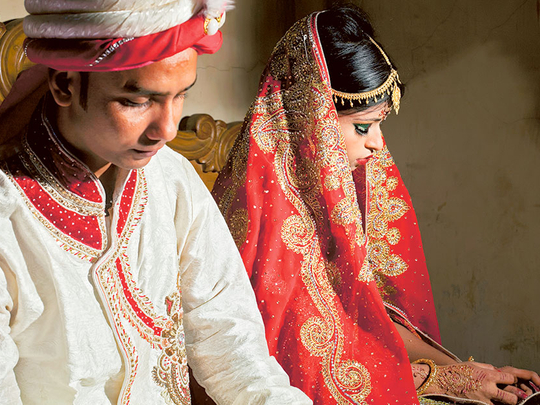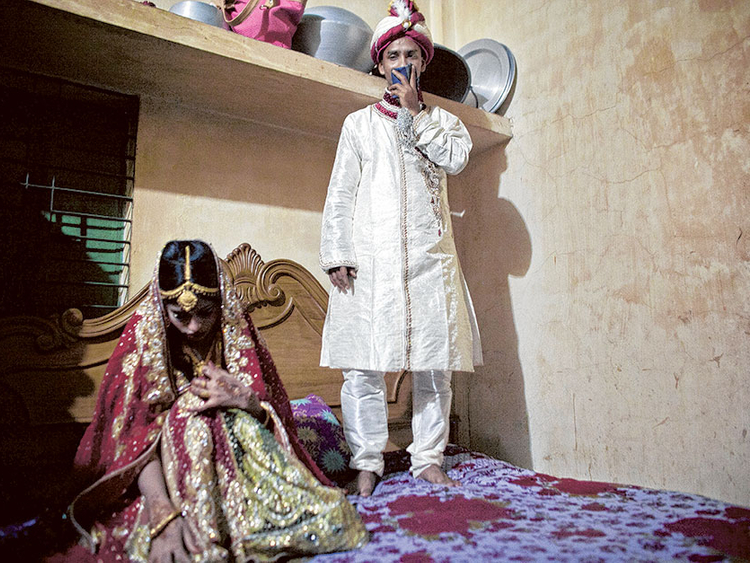
Dhaka On her wedding day, 15-year-old Nasoin Akhter looked “melancholic”, said photographer Allison Joyce, who documented the teenage girl’s wedding to her 32-year-old husband, Mohammad Hasamur Rahman, last week in Manikganj, Bangladesh.
“It’s tradition for the bride to look shy and coy during the wedding,” Joyce told The Washington Post in an email. “But I noticed this sadness and unspoken fear, and uncertainty even when she was in her room with her friends before the ceremony or at the parlour with her sister [who was also married around the same age]. She was withdrawn and quiet.”
Although Nasoin Akhter’s marriage is technically illegal in Bangladesh, laws against child marriage are rarely enforced. And despite what government officials promise and the fact that outside organisations consider it a human rights violation, the practice remains popular in Bangladesh.
According to a report published in June by Human Rights Watch, the country has the fourth-highest rate of child marriage in the world, with 29 per cent of Bangladeshi girls married before the age of 15, and 65 per cent before the age of 18.
“Child marriage around the world is associated with many harmful consequences, including health dangers associated with early pregnancy, lower educational achievement for girls who marry earlier, a higher incidence of spousal violence, and an increased likelihood of poverty,” the report states. “Global data shows that girls from the poorest 20 per cent of families are twice as likely to marry before 18 as girls whose families are among the richest 20 per cent.”
Poverty, tradition, the sexual harassment of unmarried girls and limited access to education drives the practice, convincing parents that they’re doing what’s best for their daughters, according to the report. On Instagram, Joyce wrote that Nasoin Akhter’s was the “saddest bride I have ever seen.”
Unusual circumstances
And the photographer told The Post what she found surprising about Akhter’s wedding was that her family wasn’t poor: “What was surprising to me is that Nasoin is from a very wealthy family. One of the causes cited for child marriage is poverty, but her father is a wealthy businessman with multiple two-story houses.”
Joyce, who is based in Bangladesh, has photographed other child marriages. Another young bride, 14-year-old Mousammat Akhi Akhter, said she wanted to wait until she was older when she married 27-year-old Mohammad Sujon Mia last year but, as Joyce reports, social pressure and tradition persuaded her parents to marry her just after she had finished sixth grade.
“Before their weddings they had dreams, they both loved school and had hopes for the future. Akhi’s favourite subject was math and she wanted to be a teacher, before she was married off at 13,” Joyce said. “She said that her father supported her education, but her mother saw nothing wrong with child marriage as it has been a norm in their village and community and thought it would be best for her.”
But it’s not only the desperation of poverty or social pressure that drives child marriage — it’s protection. “I photographed the wedding of Akhi’s 13-year-old sister last year, and when I asked her mother why she was marrying her daughter off, she described not feeling comfortable to let her walk to the corner store because she would be harassed by men and boys,” Joyce said.
“She also said no boy wants to marry a girl older than 18. If a girl is still single past that age people will ask too many questions ... Marriage is seen as a cover of respect and protection for women. By not going to school, it reduces the risk of being sexually active outside the house or be harassed while commuting.”
Even though Bangladesh has reduced poverty and maternal mortality, achieved gender parity in primary and secondary school enrolment, and is improving on women’s rights, it still struggles to tackle child marriage, according to the report.
The Bangladesh government’s proposed plan to tackle this issue has raised awareness — but one of its strategies was to lower the legal marriage age from 18 to 16. After an international outcry, it was put on hold. On a local level, “widespread complicity” by officials has facilitated many of the child marriages.
“Interviewees consistently described local government officials issuing forged birth certificates showing girls’ ages as over 18, in return for bribes of as little as US$1.30 (Dh4.77),” the report reads.
“The Bangladesh government has said some of the right things, but its proposal to lower the age of marriage for girls sends the opposite message,” Heather Barr, a senior researcher on women’s rights, said to Human Rights Watch. “The government should act before another generation of girls is lost.”
— Washington Post













